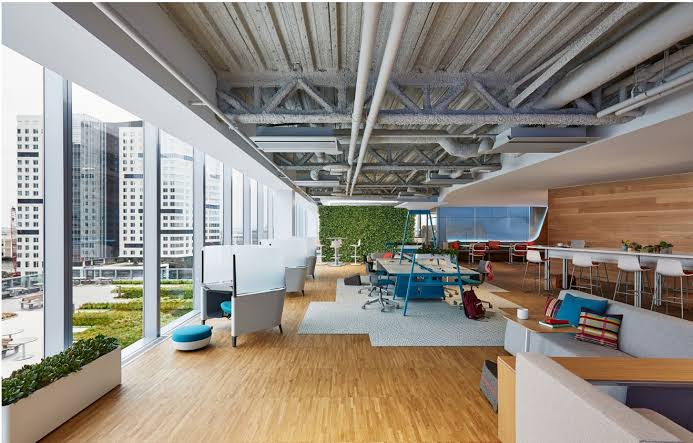The design of an office space plays a pivotal role in influencing productivity, employee satisfaction, and overall business performance. As companies continue to evolve and adapt to new working norms, understanding how office design impacts productivity is crucial. This article explores innovative office design trends and practical tips for creating a workspace that maximizes efficiency and fosters a positive work environment.
The Psychology of Office Design
Impact on Employee Mood and Productivity
The physical environment of an office can significantly affect the mood and productivity of employees.
- Color Psychology: Different colors can evoke various psychological responses. For example, blue is often associated with calm and focus, while yellow can inspire creativity and energy.
- Natural Elements: Incorporating natural elements like plants, water features, and natural light can reduce stress and increase overall well-being.
Space and Movement
The layout of an office can influence how employees move and interact within the space.
- Open Spaces: Open-plan offices can encourage communication and collaboration, but it’s essential to balance them with private areas to minimize distractions.
- Pathways and Flow: Design pathways that promote easy movement and interaction without disrupting work zones.
Innovative Office Design Trends
Biophilic Design
Biophilic design focuses on connecting office spaces with nature to improve employee well-being.
- Natural Light: Maximizing natural light can boost mood and energy levels. Position workstations near windows and use transparent partitions to allow light to flow through the space.
- Green Walls and Plants: Incorporate green walls and indoor plants to enhance air quality and create a soothing environment.
Activity-Based Working
Activity-based working (ABW) provides different workspaces for various activities, allowing employees to choose the environment that best suits their tasks.
- Zones: Create designated zones for different activities, such as quiet zones for focused work, collaborative areas for team projects, and relaxation spaces for breaks.
- Flexible Furniture: Use modular furniture that can be easily reconfigured to support different activities and working styles.
Technology Integration
Modern office design integrates technology to create a seamless and efficient working environment.
- Smart Offices: Implement IoT devices to automate lighting, climate control, and security systems, enhancing comfort and energy efficiency.
- Collaboration Tools: Equip meeting rooms with advanced video conferencing systems, interactive whiteboards, and high-speed internet to support remote collaboration.
Practical Design Tips for Enhancing Productivity
Ergonomic Workstations
Investing in ergonomic furniture can significantly improve employee comfort and reduce the risk of work-related injuries.
- Adjustable Desks and Chairs: Provide desks and chairs that can be adjusted to suit individual preferences and promote healthy postures.
- Monitor Stands and Keyboard Trays: Use monitor stands and keyboard trays to ensure screens are at eye level and keyboards are at a comfortable height.
Acoustic Solutions
Managing noise levels is crucial for maintaining a productive work environment, especially in open-plan offices.
- Soundproofing: Use soundproofing materials, such as acoustic panels and carpets, to reduce noise.
- Quiet Zones: Designate quiet zones where employees can work without interruptions.
Break and Relaxation Areas
Providing spaces for employees to take breaks and relax can boost overall productivity.
- Comfortable Seating: Create cozy seating areas where employees can unwind and recharge.
- Recreational Facilities: Include recreational facilities like game rooms, gyms, or meditation areas to promote a healthy work-life balance.
The Role of Culture and Community
Fostering a Positive Work Culture
Office design should reflect and support the company’s culture and values.
- Branding and Identity: Use office decor to reinforce company branding and values, such as displaying mission statements, logos, and brand colors.
- Inclusive Design: Ensure the office layout accommodates all employees, including those with disabilities, to create an inclusive and supportive environment.
Encouraging Collaboration and Community
Designing spaces that promote collaboration can enhance teamwork and innovation.
- Open Collaborative Areas: Design open areas with comfortable seating and whiteboards to encourage spontaneous meetings and brainstorming sessions.
- Social Spaces: Create social spaces like cafeterias or lounges where employees can interact informally and build stronger relationships.
Sustainability in Office Design
Eco-Friendly Materials
Using sustainable materials in office design can reduce the environmental impact and create a healthier workspace.
- Recycled and Natural Materials: Choose recycled or natural materials for furniture, flooring, and decor to minimize the environmental footprint.
- Low VOC Paints: Use low VOC (volatile organic compound) paints to improve indoor air quality and reduce harmful emissions.
Energy Efficiency
Implementing energy-efficient solutions can lower operational costs and contribute to sustainability goals.
- LED Lighting: Use energy-efficient LED lighting to reduce electricity consumption.
- Smart Climate Control: Install smart thermostats and HVAC systems to optimize energy use and maintain a comfortable temperature.
Adapting to Future Needs
Flexible and Scalable Design
Designing an office that can adapt to future changes is essential for long-term success.
- Modular Furniture: Use modular furniture that can be easily reconfigured to accommodate changes in team size or work style.
- Adaptable Spaces: Design adaptable spaces that can be repurposed as needed, such as converting meeting rooms into workstations or vice versa.
Embracing Remote Work Trends
As remote work becomes more prevalent, designing offices that support hybrid work models is crucial.
- Remote Workstations: Create dedicated remote workstations equipped with the necessary technology to support employees who split their time between home and office.
- Virtual Collaboration Tools: Integrate virtual collaboration tools to facilitate seamless communication and teamwork, regardless of location.
Conclusion
Office design plays a vital role in enhancing productivity, fostering a positive work culture, and supporting the overall well-being of employees. By incorporating innovative design trends, ergonomic solutions, and sustainable practices, businesses can create a workspace that not only meets the needs of their employees but also drives business success. For companies looking to rent top-rated commercial real estate, providers like Right Space Commercial Real Estate offer a range of modern, adaptable office spaces designed to support productivity and growth. Embracing these design principles will ensure that your office space remains a dynamic and productive environment well into the future.



